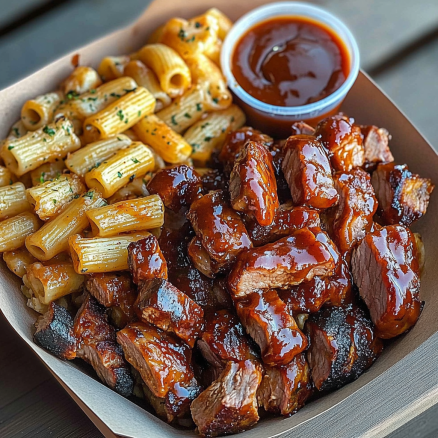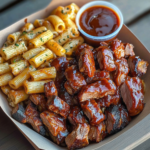Barbecue Burnt Ends are a prized delicacy in the world of smoked meats, often referred to as the “candy of barbecue.” These tender, smoky, caramelized cubes of beef are packed with rich flavor and irresistible texture. Traditionally crafted from the point end of a brisket, burnt ends have earned their place as a favorite at backyard barbecues, smokehouses, and competitions alike. This recipe showcases the magic of low-and-slow cooking, transforming a humble cut of meat into a mouth-watering dish that’s sure to impress.
Why You’ll Love This Recipe
There are many reasons to fall in love with Barbecue Burnt Ends, whether you are a seasoned pitmaster or just beginning your barbecue journey. The unique appeal of burnt ends comes from their incredible contrast in texture—each piece features a crispy, caramelized exterior and a juicy, tender interior that melts in your mouth.
You’ll love this recipe because it is:
- Flavor-packed: The combination of a well-seasoned rub, slow smoking, and rich barbecue sauce creates layers of smoky, sweet, and savory flavors.
- Perfect for gatherings: Burnt ends are an excellent dish for feeding a crowd. Their bold flavor and finger-food size make them ideal for sharing at parties, family dinners, or game-day feasts.
- Customizable: This recipe can be adjusted to suit your preferences. Whether you like your burnt ends extra sweet, smoky, or spicy, the base method allows for creative flavor combinations.
- Rewarding: While burnt ends take time to prepare, the final result is well worth the effort. The process of slow smoking and glazing allows you to enjoy the full barbecue experience and produce a dish that stands out.
Whether you serve these as the centerpiece of a meal or as a hearty appetizer, barbecue burnt ends are guaranteed to be a crowd-pleaser.
Ingredients
(Tip: You can find the complete list of ingredients and their measurements in the recipe card below.)
beef brisket point (or chuck roast as an alternative)
barbecue rub (store-bought or homemade blend of salt, pepper, paprika, garlic powder, onion powder, cayenne, and brown sugar)
your favorite barbecue sauce
brown sugar (optional, for additional caramelization)
butter (to add richness and help create a glossy sauce)
Directions
- Prepare the meat: Start by trimming any excess fat from the brisket point or chuck roast, leaving a thin layer for moisture. Cut the meat into large, uniform cubes—about 1.5 to 2 inches in size.
- Season generously: Coat the beef cubes evenly with your chosen barbecue rub. Be thorough to ensure the seasoning covers all sides for maximum flavor.
- Preheat the smoker: Set your smoker or grill for indirect heat at 250°F (120°C). Use wood chips or chunks like hickory, oak, or a blend of fruit woods (such as apple or cherry) for a balanced smoke flavor.
- Smoke the meat: Place the cubes on the smoker grate or in a wire rack. Let them smoke uncovered for approximately 3 hours, or until a dark, flavorful bark forms on the exterior of each piece.
- Add sauce and enrich: Transfer the smoked beef cubes to a disposable aluminum pan. Pour over your favorite barbecue sauce, sprinkle with brown sugar (if using), and dot with pieces of butter.
- Cover and cook further: Cover the pan tightly with foil and return it to the smoker. Continue cooking for another 1.5 to 2 hours, until the burnt ends are fork-tender.
- Caramelize the glaze: Remove the foil and cook the burnt ends uncovered for an additional 30 to 45 minutes. This step allows the sauce to reduce and cling to the meat, creating sticky, caramelized edges.
- Serve hot: Allow the burnt ends to rest for a few minutes before serving. They are delicious on their own or paired with sides like mac and cheese, coleslaw, or cornbread.
Servings and timing
This recipe serves approximately 6 people as a main course or 8 to 10 as an appetizer. The preparation time is about 20 minutes, and total cooking time is roughly 6 hours. This includes 3 hours of smoking to develop the bark, 2 hours of braising in sauce, and a final 30 to 45 minutes for glazing.
Variations
Burnt ends are highly versatile and can be customized to suit your taste:
- Spicy burnt ends: Add cayenne pepper, hot sauce, or diced jalapeños to the sauce for an extra kick.
- Sweet burnt ends: Use a honey-based barbecue sauce or drizzle honey or maple syrup over the meat during the final caramelization stage.
- Pork burnt ends: Swap the beef brisket point for pork belly or even country-style ribs for a different take on the dish.
- Asian-inspired burnt ends: Use a glaze made from hoisin sauce, soy sauce, garlic, and a touch of sesame oil for a unique fusion flavor.
- Low-sugar version: Reduce or omit the brown sugar and select a low-sugar barbecue sauce if you prefer a less sweet result.
Storage/reheating
Barbecue Burnt Ends store well, making them a great option for meal prep or leftovers:
- Refrigeration: Place leftover burnt ends in an airtight container and refrigerate for up to 4 days.
- Freezing: For longer storage, freeze the cooled burnt ends in a sealed freezer bag or container for up to 2 months. Thaw in the refrigerator before reheating.
- Reheating: To reheat, place burnt ends in a baking dish, cover with foil, and warm in a 300°F (150°C) oven until heated through. Alternatively, microwave gently in short intervals, stirring occasionally.
FAQs
What cut of meat is best for burnt ends?
The brisket point is the traditional and preferred cut because of its marbling, which keeps the meat moist and flavorful during long smoking. However, chuck roast and pork belly are good alternatives that also produce tender, juicy results.
Do I need a smoker to make burnt ends?
While a smoker delivers the most authentic flavor, you can replicate the process on a grill using indirect heat and wood chips. In a pinch, burnt ends can also be made in the oven with the addition of liquid smoke, though the flavor will differ.
How do I achieve crispy edges?
The key to crispy, caramelized edges is the final cooking stage where the meat is left uncovered in the smoker or oven. This allows the sauce to reduce and coat each piece in a sticky glaze.
Can I prepare burnt ends ahead of time?
Yes, burnt ends are perfect for advance preparation. You can smoke the meat and complete the braising phase a day in advance, then reheat and caramelize just before serving.
What wood chips work best for smoking burnt ends?
Hickory and oak provide a robust smoky flavor that pairs well with beef. For a milder smoke, consider apple or cherry wood, or use a combination for depth.
Do burnt ends have to be sweet?
Not at all. While many recipes emphasize sweetness, you can adjust the seasoning and sauce to highlight smoky, savory, or spicy elements instead.
Can I make burnt ends in a slow cooker?
It is possible to cook the meat cubes in a slow cooker for tenderness, but you will need to finish them in the oven or under a broiler to achieve the characteristic caramelized glaze.
How do I know when burnt ends are done?
Burnt ends are ready when they are fork-tender and the sauce has thickened to coat the meat. The internal temperature of the beef should be around 195°F to 205°F (90°C to 96°C) for optimal tenderness.
What are good side dishes for burnt ends?
Classic sides include macaroni and cheese, baked beans, potato salad, coleslaw, cornbread, and pickles. These accompaniments balance the richness of the burnt ends.
Can I make burnt ends with a gas grill?
Yes, you can use a gas grill set up for indirect cooking. Place a smoker box with wood chips over one burner to add a smoky flavor.
Conclusion
Barbecue Burnt Ends are a true celebration of slow cooking and bold flavors. From the initial seasoning to the final sticky glaze, each step in the process builds the rich, smoky, and satisfying taste that makes burnt ends so beloved. Although the preparation requires time and care, the reward is a plate of tender, caramelized meat that is perfect for any gathering or special meal. Whether you are hosting a backyard barbecue or simply craving a taste of authentic smoked beef, this recipe delivers a result that is sure to impress and delight.
If you are looking to elevate your barbecue repertoire, Barbecue Burnt Ends are an essential dish to master. With their balance of texture and flavor, they embody everything that makes smoked meats so satisfying. Adjust the seasonings, sauces, and sides to your liking, and enjoy the process of creating this barbecue classic.
PrintBarbecue Burnt Ends
Barbecue Burnt Ends are a beloved smoked meat delicacy featuring tender cubes of beef coated in a rich, sticky barbecue sauce, with crispy, caramelized edges and juicy centers. Perfect for barbecues, game days, or as a hearty main course.
- Prep Time: 30 minutes
- Cook Time: 5 hours 30 minutes
- Total Time: 6 hours
- Yield: 6 servings
- Category: Main Course
- Method: Smoking
- Cuisine: American
- Diet: Gluten Free
Ingredients
- Beef brisket point or chuck roast
- Barbecue rub or seasoning blend
- Your favorite barbecue sauce
- Brown sugar (optional for added caramelization)
- Butter (for richness)
Instructions
- Preheat your smoker or grill to 250°F (120°C).
- Trim excess fat from the brisket point or roast and cut into large cubes.
- Coat the meat generously with barbecue rub.
- Place the cubes in the smoker and cook for 3 hours or until a dark bark forms.
- Transfer the meat to a disposable pan, add barbecue sauce, brown sugar, and butter.
- Cover with foil and cook for an additional 1.5 to 2 hours until tender.
- Remove foil and cook uncovered for 30 minutes to allow the sauce to thicken and caramelize.
- Serve hot with extra sauce on the side.
Notes
- For a spicier version, add cayenne pepper or hot sauce to the barbecue sauce.
- Can use pork belly instead of beef for a different take on burnt ends.
- For a sweeter glaze, add honey or maple syrup during the final cooking phase.
- Store leftovers in an airtight container in the refrigerator for up to 4 days.
- Can freeze burnt ends for up to 2 months.
- Classic sides to serve with burnt ends include coleslaw, mac and cheese, baked beans, and cornbread.
Nutrition
- Serving Size: 1 serving
- Calories: 450
- Sugar: 12g
- Sodium: 700mg
- Fat: 30g
- Saturated Fat: 12g
- Unsaturated Fat: 15g
- Trans Fat: 0g
- Carbohydrates: 10g
- Fiber: 1g
- Protein: 35g
- Cholesterol: 120mg


